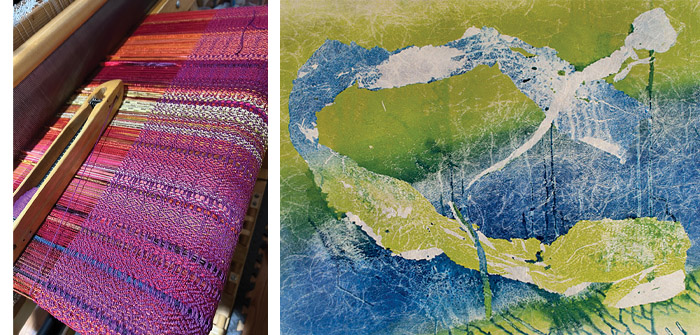((L) Weaving by Stephanie Stanley (R) Spiritual Energy by Michelle Lindblom)
Stephanie Stanley — Weaver
When you see a photo or video of a weaver gracefully throwing the shuttle on a loom, it looks easy. What you don’t see is the hours of preparation required before the weaver even sits down to weave. Stephanie Stanley, whose woven garments are showcased in June at Red Chair Gallery, explains that many technical skills must be mastered before you can create a thing of beauty.
“It takes more time to put the warp on the loom than to weave a whole scarf,” she says. “There are a lot of steps before you can actually start weaving.” The way you thread the shafts on a loom affects the pattern you weave. A scarf might require 300 pieces of thread, each cut exactly the same length, to be threaded on the shafts of the loom to create the warp. With just a four-shaft loom, you can create 20 different patterns with one threading. This is because the threads can be inserted in a number of different combinations and the treadles can be tied to the shafts in various ways. Additionally, the weaving pattern can be changed by the order in which the treadles are pressed down.
After the weaving is completed, there is still more work to do. Stanley “wet finishes” the garments in soapy water, dries them and sometimes fluffs them in a dryer. For some scarves, the threads are twisted into a plied fringe. Most of the fabrics must be pressed three times to “settle in” the fibers, Stanley explains.
Stanley owns six looms, all of them floor looms and the largest of which is five feet wide. They range from 4 to 24 shafts. They take up one bedroom and a sunroom in her house. She weaves her scarves and ponchos from different types of natural fiber, including organic and conventional cotton, wool, silk, bamboo and tencel, which is a silky type of rayon that is made from wood pulp (cellulose). Stanley notes that the manufacturing process for Tencel does not release chemicals into the environment. “I try to use materials that are sustainable,” she says. Come into the gallery to see her gorgeous creations in June.
Michelle Lindblom — Artist
Michelle Lindblom is a multi-talented artist. Last month, Red Chair Gallery featured her abstract oil and acrylic paintings and this month it presents her monotypes.
According to the Museum of Modern Art in New York, a monotype is a one-of-a-kind print made by applying paint or printing ink to a flat sheet of metal, glass or plastic. The painted image is transferred to paper by using a press.
For her monotypes, Lindblom uses a sheet of plexiglass cut to the required size and then bevels the edges and roughs up the surface with sandpaper so that it holds the printing ink well. She then applies water-based inks and adds textured materials such as dried flowers and leaves, fabric or even a snakeskin and lays the plexiglass on thick print-making paper that has been soaked in water. The sandwiched materials are rolled through a press to create a unique print. “I don’t quite know what’s going to come out on the other side,” she says, but she likes the “spontaneity” of the process.
Lindblom uses a wide variety of mostly natural matter for her monotypes. She cultivates wildflowers in her garden, which she dries. She saves and recycles other things like mesh, ribbon and rope for prints. “I like to repurpose things rather than throwing them out,” she explains. The snakeskin was not something Lindblom anticipated using until a artistic friend whose son raises snakes offered to send her snakeskins that had been shed. When the package arrived in the mail, she remembers “I didn’t open it for about six months because I was afraid of them.”
Lindblom, who has an undergraduate degree in visual art from the University of New Orleans and an MFA from the University of North Dakota, taught art for 24 years at Bismarck State College. She and her husband moved to Bend in 2015 and she has been a member artist at Red Chair Gallery since 2017
In the Midwest, Lindblom had many solo exhibitions at venues and galleries around the region. She is a member of the National Association of Women Artists and has been juried into several exhibitions, four in New York City. Here in Bend, she has participated in exhibitions at various venues: The Alexander, Oxford Hotel, and Franklin Crossing, Sage Gallery and Framing, UUFCO and the Commons Café. This spring her work was accepted into two online exhibitions through Manhattan Arts International, “Herstory” and National Association of Women Artists, “At a Crossroads.”
You can read Lindblom’s blog at m-lindblom.medium.com.

